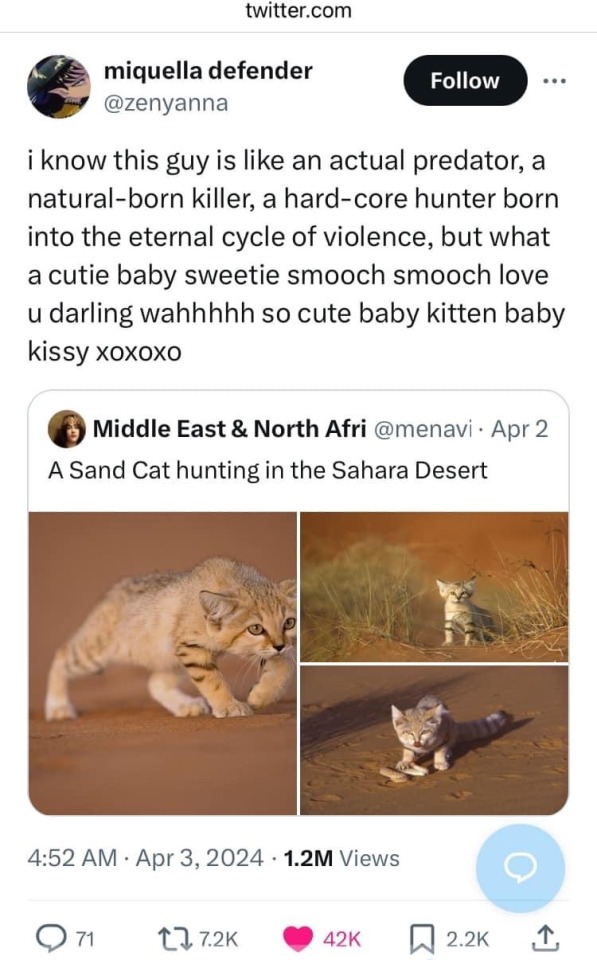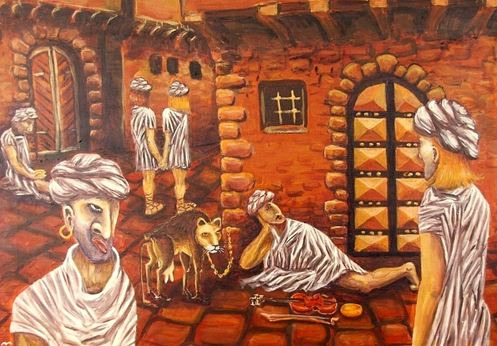#fertile crescent
Text
Humans in the Fertile Crescent circa 8000 BCE:

60 notes
·
View notes
Photo

The fertile crescent, heart of the neolithic revolution.
by LegendesCarto
123 notes
·
View notes
Text
Source: THE FUCKING EUPHRATES RIVER!!!!
#personal stuff#dougie rambles#euphrates river#rivers#mesopotamia#bethnahrin#my poor attempt at a joke#source#bronze age#bronze age memes#bronze age collapse#sea peoples#Bronze Age shitposting#shitpost#highbrow shitposting#Tigris river#Fertile Crescent#middle east#Asia
49 notes
·
View notes
Text
Nasnas
In Arab folklore, the Nasnas is a monstrous creature. According to Edward Lane, the 19th century translator of The Thousand and One Nights, a nasnas is "half a human being; having half a head, half a body, one arm, one leg, with which it hops with much agility". In Somali folklore there is a similar creature called "xunguruuf" or "Hungruf". It is believed it can kill a person by just touching them and the person would be fleshless in mere seconds. It was believed to be the offspring of a jinn called a Shiqq and a human being. A character in "The Story of the Sage and the Scholar", a tale from the collection, is turned into a nasnas after a magician applies kohl to one of his eyes. The nasnas is mentioned in Gustave Flaubert's The Temptation of Saint Anthony.

2 notes
·
View notes
Photo

This Natufian woman from around 15,000 to 11,500 years ago appears to be deep in thought as she gazes upon the landscape that will become the area encompassing modern Israel and Palestine, Lebanon, and Syria. A culture of hunter-gatherers who settled in permanent villages, the Natufians are believed to be the immediate precursors to some of the earliest Neolithic farmers in the Fertile Crescent.
#Natufian#mesolithic#prehistoric#middle east#fertile crescent#archaeology#anthropology#north african#black woman#woman of color#dark skin#WOC#digital art#art
11 notes
·
View notes
Text
Although indigenous wild plants were undoubtedly domesticated in Africa's Sahel zone just south of the Sahara, cattle herding may have preceded agriculture there, and it is not yet certain whether those were independently domesticated Sahel cattle or, instead, domestic cattle of Fertile Crescent origin whose arrival triggered local plant domestication.
"Guns, Germs and Steel: A Short History of Everybody for the Last 13,000 Years" - Jared Diamond
#book quote#guns germs and steel#jared diamond#nonfiction#sahel#africa#sahara#domestication#farming#cattle#fertile crescent#near east
2 notes
·
View notes
Quote
Dravidian constitutes one of the primary linguistic groups in the proposed Nostratic language system, linking almost all languages in North Africa, Europe, and Western Asia into a common family with its origins in the Fertile Crescent sometime between the last Ice Age and the emergence of proto-Indo-European four to six thousand years B.C.E.
https://www.newworldencyclopedia.org/entry/dravidian_peoples
2 notes
·
View notes
Text
youtube
Fertile Crescent - Bad Religion
Come and see the brilliant light
Don't let your emotions mask your sight
It's a manifestation of a deeper fight
That affects me and you
My optimism was running high
A new world order was on my mind
But I couldn't believe it when I heard them say
They're throwing it away
And the fertile crescent is burning today
And baby, my emotions are, too
The cradle of humanity has led us all astray
And we're all in this together, don't you know?
'Cause our species has nowhere else to go
Aggression rears its ugly head
Retaliation brings further dread
The two are linked by unseen threads
That wind back through time
I don't agree with this outdated trend
Nationalism's an evil friend
Hatred's instilled by invisible lines
Drawn in our minds
And the fertile crescent is haunting us today
And baby, our instincts are, too
The ghost of humanity is warning us this way
And I think we all should heed it, don't you know?
'Cause we've got nowhere else to go
The fertile crescent is haunting us today
And baby, our instincts are, too
The ghost of humanity is warning us this way
And I think we all should heed it, don't you know?
'Cause we've got nowhere else to go
Lyric source
#israel#iran#gaza#palestine#war#atrocities#fertile crescent#lyrics#music#1992#originally about the gulf war but topical today#Youtube#bad religion
1 note
·
View note
Text
had to explain to someone (a beloved friend) that Neo-Babylon was a real thing and not something I made up for a fantasy story
1 note
·
View note
Text
Table 18.1 summarizes approximate dates of the appearance of key developments in the main "homelands" of each hemisphere (the Fertile Crescent and China in Eurasia, the Andes and Amazonia and Mesoamerica in the Americas). (...) Some of the dates in Table 18.1 are very uncertain, especially those for the onset of American food production. (...) Still, even if plant domestication did begin earlier in the Americas than the dates shown in Table 18.1, agriculture surely did not provide the basis for most human calorie intake and sedentary existence in American homelands until much later than in Eurasian homelands.

As Table 18.1 summarizes for England, once food production and village living had arrived from the Fertile Crescent after a long lag (5,000 years), the subsequent lag for England's adoption of chiefdoms, states, writing, and especially metal tools was much shorter: 2,000 years for the first widespread metal tools of copper and bronze, and only 250 years for widespread iron tools.
"Guns, Germs and Steel: A Short History of Everybody for the Last 13,000 Years" - Jared Diamond
#book quotes#guns germs and steel#jared diamond#nonfiction#fertile crescent#china#eurasia#andes#amazonia#mesoamerica#the americas#food production#plant domestication#england#village life#chiefdom#state#writing systems#metal tools#tool use#copper#bronze#iron
0 notes
Text

Ghilman
[singular - Ghulam]
were slave-soldiers and/or mercenaries in armies throughout the Islamic world. Islamic states from the early 9th century to the early 19th century consistently deployed slaves as soldiers, a phenomenon that was very rare outside of the Islamic world.
Gift for @megafunk
#sketch#furry#anthro#gift art#original character#what is a pale white lizard doing south of the fertile crescent?
173 notes
·
View notes
Photo

"The Fertile Crescent", named by archaeologists at the beginning of the 20th century, stretches from Egypt to southern Mesopotamia. This zone characterized by a rich biodiversity (cereals, abundant legumes as well as animals) contrasted with the aridity of the neighboring deserts.
by @LegendesCarto
150 notes
·
View notes
Photo

Etel Adnan, from ‘Jebu’, Women of the Fertile Crescent: An Anthology of Modern Poetry by Arab Women (ed. & trans. Kamal Boullata)
[Text ID: “this body pierced with holes / burned
by sulfur opened by manganese / wounds
on its mouth and petroleum for its
kisses
refugee with no refuge”]
#q#lit#quotes#poetry#etel adnan#jebu#women of the fertile crescent#typography#of war and violence#reading#m#x
565 notes
·
View notes
Note
I am EXTREMELY curious about “The Absolution of Ea-Nasir”
I'm excited about the results!
Several months ago, I started wondering 1. Was Ea-Nasir's copper really bad? and 2. How was it bad from a metallurgist perspective? So I went digging, and, as with many archaeological topics, there's not a conclusive answer. But TLDR: Ea-Nasir wasn't necessarily an intentional grifter. He was a victim of his time and challenging geopolitics. I personally think he was a fonder of his city than his fellow merchants, who he probably considered money-gubbers with poor loyalties. ... He was definitely a dick though.
#I've grown quite fond of him through my readings!#I haven't written this up yet because I have 25+ sources and 2 pieces of evidence are in translation-contention.#There's growing evidence/suspicion that fertile crescent smelters might've used oil instead of charcoal but it's a half-baked theory#based on a much older a poorly-known Islamic source. The Islamic source might've been mistranslated; so I have to dig into that.#But if it ISNT. There's grounds for an environmental change in Oman decreasing fuel resources for smelting that might've affected#our boi in Mesopotamia. Even if it is a translation error though: the affects of the environmental shift have been recorded#in enough detail I think there are enough grounds for Why.
52 notes
·
View notes
Photo

This is a sketchbook doodle of a forager woman from the Natufian culture of prehistoric western Asia between 15,000 and 10,000 years ago. The tool she is carrying in her right hand is a sickle edged with sharp little stone blades which she uses to harvest wild grasses.
#natufian#prehistoric#fertile crescent#mesolithic#hunter-gatherer#black woman#dark skin#woman of color#woc#drawing#traditional art#art
2 notes
·
View notes